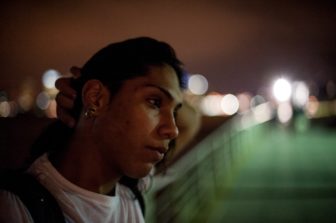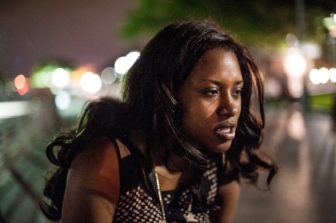Transgender teens come from all over New York to find refuge on Christopher Street but soon discover they are underserved by social-services agencies. Instead, they find comfort in each other and those who came before them.

Robert Stolarik
Joseph, 21, on pier 45 on the west side of Manhattan.
NEW YORK– Years ago, before the pilings had gone rotten and jagged like a row of rotten teeth, the piers were still lined with abandoned houseboats. At a time when gay sex was illegal, this was a busy pick-up spot. The empty homes gave cover from the elements and a semblance of privacy. Sometimes a boat’s floor gave way, and its occupants would drown in the Hudson River. Still, for gay men and trans teens, the block at the end of the West Village was a refuge from a hostile culture.
The piers have undergone an almost unrecognizable transformation from just 10 years ago, when the city began renovating the stretch of waterfront that runs parallel to the historic West Village, let alone 50 years ago, when the bodies of young gay and transgender men would be fished out of the river. Today, luxury condominiums line the highway, and the crumbling waterfront has been transformed into a park frequented by tourists and locals.
“Kids are arriving every day,” said Kate Barnhart, executive director of New Alternatives, an organization that helps homeless LGBTQ teens and young adults. “They’re coming from places that are not trans-safe, like the south and the midwest, and they know that New York is a cool place to be gay. They’re constantly arriving.”
Numbers on trans teens in New York City are largely anecdotal, because there is no system in place by the city or state to formally track the population. But nationally, the outlook for trans teens is grim, according to a survey of 6,450 transgender and gender non-conforming study participants conducted by the the National Gay and Lesbian Task Force and the National Center for Transgender Equality. Many of the respondents lived, like the pier teens on Christopher Street, in poverty, with participants four times more likely to have a household income of less than $10,000 per, year compared to the general population.
Climbing out of that poverty is nearly insurmountable. Survey participants reported unemployment at twice the rate of the general population. Rates for trans people of color were four times the national unemployment rate. Unable to find a job, 16 percent of survey respondents said they turned to the underground economy to survive, mostly turning to prostitution. The trans kids on Christopher Street say that number is much higher for them, and that prostitution is almost a rite of passage for many.
Many trans youth don’t finish school. Those who expressed a transgender identity or gender non-conformity during school reported high rates of harassment, physical assault and sexual violence. Harassment was so severe that it led almost one-sixth to leave a school, according to the survey.
On a recent Saturday evening, a lean folk singer serenaded a group of white diners at a newly opened cafe. His strumming was within earshot of a group of black homeless teens, all of them either gay or transgender, bearing out the stats — dropouts and looking for work, scraping by hustling to make enough money to eat.
Despite the stunning changes that have occurred here, one thing remains the same — they flock here, like an Ellis Island for queer youth. They come, said Elegance Bratton, like he did when he was a teen, often banished from the family after being caught living a double life at, and are desperate for a haven. Christopher Street and the piers in the West Village still remain a refuge, even as their presence becomes more incongruous as the piers have been converted into a gentrified wonderland.
Bratton has seen what this life is like. When he was just 16, he lived it. Now, as a student at Columbia University, the former Marine has recently acquired his own apartment and is shooting “Pier Kids: The Life,” a documentary featuring gay and trans kids who have survived the streets and what he calls an anemic nonprofit industrial complex.
“Most of the trans men and women I’ve met out here come when they’re kids,” said Bratton. “Half of the networking is in the shadows. You might meet [someone who’s in a position to help] who can rent a room to you. But that lasts a month. Eventually those connections fail. Desperation sets in.”
What these new arrivals soon discover is that they are woefully underserved by the city, often encountering harassment and ridicule by mainstream social-service agencies. Even in a city as welcoming to queer teens as New York City, they have to confront the reality that despite its openness it is still strapped for cash and short on resources for the whole youth population, and that there are fewer places tailored specifically for transgender teens, and many still treat them as alien.
According to the Task Force study, trans teens endure widespread abuse in the public sector and reported that they were often abused at the hands of “helping” professionals and government officials. One-fifth of survey respondents said they were denied equal treatment by a government agency or official; and 29 percent reported police harassment or disrespect; and 12 percent had been denied equal treatment or harassed by judges or court officials.

Robert Stolarik
Tatiana, 20, on pier 45 on the west side of Manhattan.
There’s only one city-run shelter for transwomen, none for transmen. The state agency that licenses the operators of youth shelters have no option for transgender teens — there’s a box for boys and girls. Teens complain of being treated like freaks when they go for routine services.
Many experts said that one of the pluses of being diagnosed with HIV or AIDS is that you are more likely to find a place to live if you’re infected. Circumstances are so dire for many of these teens, Bratton said contracting AIDS or HIV can be seen as a warped blessing. “If you’re a poor queer, black kid the quickest way to get into a home is by getting AIDS,” he said. “That is a slam dunk. You will go from being on the street Monday to being in an SRO Friday.”
Instead, experts say, they rely on under-funded and overwhelmed boutique LGBTQ organizations that are incapable of handling the load of transgender teens who come for help.
In the years after the Stonewall riots, many gay and trans teens turned to the ballroom community to fill the void. The ballroom scene is part event, part nightlife lifestyle. Members of different groups compete in “walks,” dances, such as Voguing, and in dressing like other genders and social classes. But it is more than just parties and glamorous events. Bratton, a ballroom participant, described it as the Grammys meets a part black church social meets Hollywood.
The ballroom demimonde provides a surrogate family for many of the gay and trans teens who have been banished from their homes and are desperate for direction and a sense of belonging. The rival groups from the ballroom are comprised of families, a parallel institution made up of house Mothers, who are often but not exclusively trans or in drag, and house Fathers. They offer advice on how to navigate the streets, the way a parent would offer guidance to a child.
“There were few, if any, organizations dedicated to homeless LGBT youth, who were coming out at younger and younger ages and being discarded to the streets in droves,” said Carl Siciliano, the director for the Ali Forney Center, an organization that creates home-like environments for homeless queer youth. “In the absence of organized support, the ballroom community responded to the needs of these desperate and abandoned youths by forming “Houses.” This was pretty much the only way these youths could find acceptance and support.”
With places like the Ali Forney Center, Trinity House and New Alternatives, the support has become more organized, but the problem is too big for them to handle alone, Bratton said, sitting on a bench at the end of a pier on a recent Saturday evening.
“Even more troubling from the racial component is seeing this endless pipeline of kids from surrounding ghettoes in New York City — of queer youth of color kicked out of their houses,” he said. ‘It’s a way of consigning yourself to an economic dungeon if you are a trans youth of color.”
Joseph Orta, 21, considers himself a “pretty boy.” Orta, who is Latino, likes to dress up like a woman. He has a series of photos in his phone that he is proud to show. They are of him and his best friend, Lamar, who is transitioning to be a trans woman. Orta is wearing a red Armani cocktail dress, black wedges, necklace, earrings and what he describes as a “classy makeup job.”
When Orta was a teenager he thought he would go through with the gender transition. Now that he is older, Orta said, he is content to be a pretty boy without going through an arduous medical process of transforming his body. “At the end of the day,” he said, “I’m a boy.”
Orta said he and his friends hear the whispers when they go to mainstream social services. When he and a friend recently visited a health clinic, he could see the staff staring and whispering. A nurse came over, Orta recalled, and threw some forms at her: “‘Here’s your stuff, nigga,’ she said instead of saying, ‘here you go, miss’.”
“No matter how you look at yourself, if you are transgender they still look at you as a man, and treat you that way, and judge you,” Orta said. “They look at you like you’re alien.”
On Sunday nights, at St. John’s Episcopal Church on Christopher Street, in the heart of West Village, Barnhart hosts a dinner that is followed by a crash course in navigating the system for LGBTQ youth in need.
Outside the eight-foot tall black wrought-iron gate, someone hung what looks like laminated, oversized bookmarks with the names of LQBTQ teens who have been been attacked. The names with a black band around them indicate the kids who were killed. The banners swayed in the warm breeze on a recent Sunday while the police escorted out someone who had gotten violent at one of the meetings.

Robert Stolarik
Lauren, 21, on pier 45 on the west side of Manhattan.
Barnhart has a transgender client who was told by a counselor at a mainstream shelter that the only way she was going to get a job is if she cut her hair and dressed like a boy. At a recent meeting with a Catholic social-service provider, she had an exchange that illustrated this mindset: She said she asked for the organization to stop sending straight kids to New Alternatives since it is for LGBTQ youth. The woman responded: “I’ll let them know that you don’t take normal kids.” Barnhart, who has worked with queer homeless youth for more than a decade, said there is a crisis for gay youth in the city, but it’s compounded for transkids. Their problems are more acute. They face a number of idiosyncratic challenges to climbing out of a hostile social-services system and onto a path toward stability.
“If that’s how the professional staff is thinking, imagine what the administrators are thinking,” she said.
That’s an acute problem when so many of the population are in need of help from a range of social services, like housing. Nearly one-fifth of the respondents to the Task Force report said they were homeless at some point because they were transgender or gender nonconforming. The majority of those trying to access a homeless shelter were harassed by shelter staff or residents, and nearly one-third were turned away altogether. More than one-fifth said they were sexually assaulted by residents or staff.
Getting a job is equally frustrating, Barnhart said. “It’s especially bad with the homeless youth because its hard for them to do all the things they need to do to make themselves look presentable for the opposite gender,” she said. “They can’t afford electrolysis; they can’t afford make up; they can’t afford clothes. They end up looking half baked because they can’t fully transition, and that leads to a lot of employers not even granting them an interview, let alone offering them a job.”
Another problem, experts say, is acquiring all the proper government identification forms to navigate the network of social services in the city. Most of these teens leave their homes after a fight and don’t have the opportunity to collect things like identification cards and birth certificates. When they do enter social services, they encounter prejudice and ridicule.
Barnhart said she recently sent one client to Bellevue Hospital Center for post-exposure to the HIV virus. When the client, a transgender teen girl, went to use the women’s bathroom, she got hassled by the security guard.
She said she was able to arrange Bellevue’s staff with someone who does training for trans people, but added that it shouldn’t be her job to go around teaching New York City proper behavior. “People should be able to get the medical care they need without having to worry about getting harassed,” Barnhart said.
Another client was humiliated at her temporary housing. The security guard taped her original male identification card to the plexiglass booth at the entrance to mock her. That’s a story that trans teens tell again and again. It’s a popular malevolent prank pulled by the staff at many of the homeless shelters and health clinics.
“These workers who staff these social services, they desperately need some training,” she said. “And there needs to be some accountability.”
Orta said mainstream agencies are clumsy, at best, in dealing with transkids, and hostile at worst. Coupled with the shortage of LGBTQ agencies that are equipped to help transkids, many turn to prostitution to make ends meet, or exchange sex for a place to live for awhile before the John kicks them out.
“I met so many transgender girls when I was a prostitute,” Orta said. “They would tell me, ‘I just want to be a normal girl.’ That’s it. That’s the one dream they all have.”
“There’s a network of support out here on the piers and on Christopher Street,” he said. “But it’s not always the right kind of support.”
Orta’s story is similar to many of the pretty boys and trans teens who scrape together a life on Christopher Street. He comes from a poor family. He was placed in foster care in Brooklyn and abused by his foster mother’s boyfriend, who had just come out of prison. He is now a senior in high school. He said he had a lot of support from the administration at school, his friends and the staff at Ali Forney. He has been homeless, a prostitute, and lived bouncing from one precarious housing situation to the next. He has resolved to leave that behind. He has housing with Ali Forney and is looking for a long-term job.
Orta, is lucky, said Bratton. Many of the trans teens out on the piers have no hope. They can’t conceive of something beyond life on the piers. He remembers the first time one of them referred to a transgender girl who had secured HIV housing as “middle class.” He couldn’t believe it. He had visited the “middle class” girl at her apartment. She was making $600 per month. She lived miles from a subway station in the “ass-end” of the Bronx, in a shabby apartment in a desolate neighborhood that had a Chinese take-out joint, a liquor store and derelict industrial warehouses.
“If they think that girl is middle class, what must they think about the people who live in those places that stare out at them every day,” he said pointing to the luxury buildings catching the setting sun’s dying rays off their steel and glass edifices. “They must think they’re another species.”





























